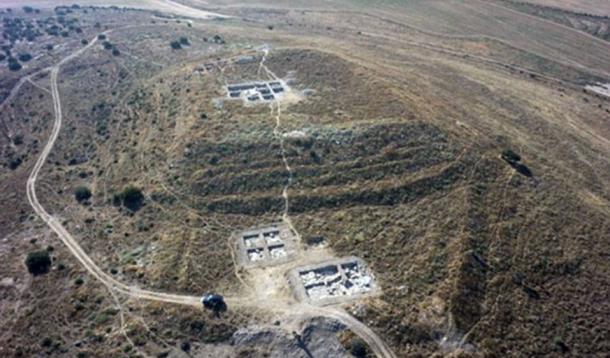Guest
Guest
 |  Subject: Could Iron Age settlement be the biblical town of Libnah from the Book of Exodus? Subject: Could Iron Age settlement be the biblical town of Libnah from the Book of Exodus?  Tue Feb 10, 2015 10:02 pm Tue Feb 10, 2015 10:02 pm | |
|  10 FEBRUARY, 2015 - 22:37 LIZLEAFLOORCould Iron Age settlement be the biblical town of Libnah from the Book of Exodus?Excavations at Tel Burna, an Iron Age settlement in the Shephelah region of modern-day south-central Israel, have revealed artifacts and fortifications dating back to the seventh and eighth centuries. Some scholars are suggesting these finds might indicate that archaeologists have located the site of the biblical town of Libnah.Dr. Itzhaq Shai, project director and assistant professor at Ariel University, told Popular Archaeology, “The identification of the site has been debated for more than a century. There are scholars who have claimed that Tel Burna is biblical Libnah, which was mentioned several times in the Bible. This identification was based mainly on geographical and historical arguments. […] To date, there are other candidates for the location of ancient Libnah, including nearby Tel Zayit; however, the exposed archaeological remains at Tel Burna support this identification, with both the geographical, survey and excavation data fitting well with what we know and expect from a border town in the Iron Age.” 10 FEBRUARY, 2015 - 22:37 LIZLEAFLOORCould Iron Age settlement be the biblical town of Libnah from the Book of Exodus?Excavations at Tel Burna, an Iron Age settlement in the Shephelah region of modern-day south-central Israel, have revealed artifacts and fortifications dating back to the seventh and eighth centuries. Some scholars are suggesting these finds might indicate that archaeologists have located the site of the biblical town of Libnah.Dr. Itzhaq Shai, project director and assistant professor at Ariel University, told Popular Archaeology, “The identification of the site has been debated for more than a century. There are scholars who have claimed that Tel Burna is biblical Libnah, which was mentioned several times in the Bible. This identification was based mainly on geographical and historical arguments. […] To date, there are other candidates for the location of ancient Libnah, including nearby Tel Zayit; however, the exposed archaeological remains at Tel Burna support this identification, with both the geographical, survey and excavation data fitting well with what we know and expect from a border town in the Iron Age.” Aerial view of excavated areas at Tel Burna. Credit: Chris McKinny According to International Business Times, the artifacts indicate a Judahite presence. The dating and location of the finds suggest to researchers at the Tel Burna Excavation Project that this was one of the places where Israelites stopped during the Exodus out of Egypt, as referenced in the Hebrew Torah and the Christian Bible. This area subsequently developed into a town in the Kingdom of Judah.MORE
- Has the lost Biblical town of Dalmanutha been found?
- Archaeologists find 2,000-year-old mansion which probably belonged to enemy of Jesus
- Legendary citadel captured by King David may been found
The site of Tel Burna was primarily inhabited in the Bronze and Iron Ages, and was one of a series of sites along the border between the kingdoms of Judah and Philistia in the Iron Age. Numerous discoveries have been made since the Tel Burna Excavation Project, headed by archaeologist Dr. Shai, first began investigating the site in 2010, including fortifications, domestic areas, and numerous silos for grain storage. The research team have uncovered numerous intriguing structures and artifacts that point to the presence of a cult complex used for sacrificial rituals and ceremonies.Images from left to right, top to bottom: Bes figurine, the ‘Lady of Burna’ figurine, nose from a mask, unique triplet vessels connected to each other, Egyptian scarab. Credit: The Tel Burna Excavation Project. Archaeologists have estimated that the cult complex was large, with a courtyard measuring 52 by 52 feet (16 by 16 meters). Inside the ancient structure, researchers have uncovered numerous artifacts that suggest the site was used for religious worship, including fragments of facemasks, which may have been used in cultic ceremonies; giant storage vessels from Cyprus, possibly used as storage for tithes brought to the cultic complex; figurines, some of which look part animal, part human; a scarab, which is an artifact with an Egyptian hieroglyphic inscription on it; three connected cups, currently been analyzed for residues; numerous goblets and chalices; and burnt animal bones, which may indicate sacrificial rituals or feasts.The location of the site in relation to the ancient kingdoms, as seen above. Credit: The Tel Burna Excavation Project. Popular Archaeology reports that Dr. Shai and the team will continue with excavations in the upcoming year, and details will be updated on the project website.The aim of the Tel Burna Excavation Project is to continue with the open excavation in which all are welcome to join and participate. The community of archaeologists and researchers are working “towards the preservation and reconstruction of features that will make the site more understandable and interesting to visitors.”Featured Image: Aerial view of section B of the excavation site, where archaeologists believe a cult complex once stood. Credit: The Tel Burna Excavation Project.By Liz Leafloor- See more at: http://www.ancient-origins.net/news-history-archaeology/could-iron-age-settlement-be-biblical-town-libnah-book-exodus-002662#sthash.Nij69nM6.dpuf |
|





